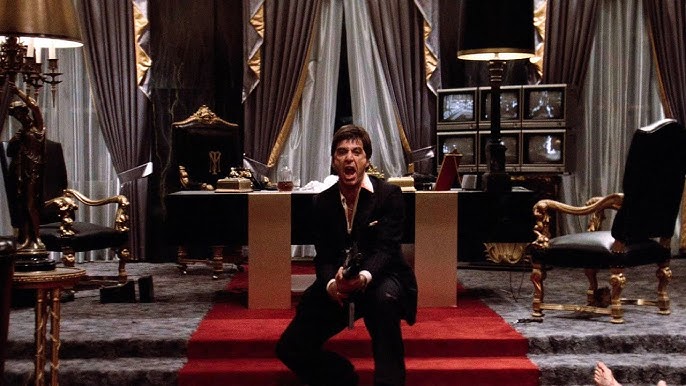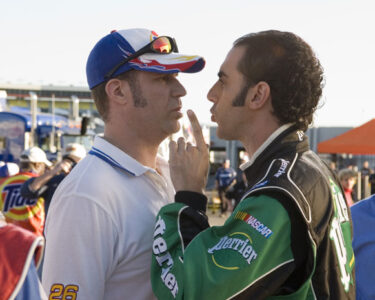The 1983 film Scarface, directed by Brian De Palma and written by Oliver Stone, is a crime drama that has etched its place in cinematic history. Beyond the film itself, the Scarface movie poster has achieved a similarly iconic status.
Its minimalist yet powerful design has been reproduced, parodied, and referenced across decades, not only as a piece of film promotion but as a cultural symbol. This essay explores the visual design, thematic depth, cultural impact, and symbolism embedded in the Scarface movie poster, examining how a simple black-and-white image can evoke complex ideas of duality, ambition, and downfall.
Visual Design and Aesthetics
At first glance, the Scarface movie poster stands out due to its stark black-and-white color scheme. The image is divided vertically down the center, with a white background on the left and a black background on the right. Tony Montana, portrayed by Al Pacino, stands at the center of this divide.
His figure overlaps the two halves, with one side of his body bathed in white light and the other in darkness. This color contrast immediately grabs attention and serves a crucial symbolic function, representing the dichotomy within Montana himself—his dual nature, the moral ambiguity of his actions, and the thin line between good and evil.
Montana is dressed in a white suit, a nod to 1930s gangster fashion, holding a gun loosely in his hand. His face is intense, almost devoid of emotion, which adds to the poster’s cold, calculating aura.
The title Scarface is emblazoned in bold red font on the right side of the poster, providing the only color and, by extension, the only element of emotional heat. The red lettering is suggestive of blood, violence, and passion—central themes to the narrative arc of the film. The tagline, “He loved the American Dream. With a vengeance,” accompanies the image, succinctly summarizing the film’s core premise.
Symbolism and Themes
One of the most notable aspects of the Scarface poster is how it encapsulates the film’s major themes in a single image. Tony Montana’s placement at the intersection of black and white not only alludes to his personal journey from rags to riches and his moral ambiguity but also to his internal conflict and the external pressures he faces.
The black-and-white imagery underscores the film’s core theme of duality: the immigrant dream versus the brutal reality of criminal enterprise, power versus vulnerability, ambition versus self-destruction.
The red text is more than just a stylistic choice; it represents bloodshed and the violent path Montana takes to achieve his version of the American Dream.
It also foreshadows his inevitable downfall. In the movie, Tony climbs to the top of the drug empire but becomes increasingly paranoid, violent, and isolated. The red title, juxtaposed with the stark monochrome background, hints at this unraveling. It also serves as a metaphor for the price of ambition—success achieved through blood.
Furthermore, Montana’s white suit can be interpreted as ironic. White traditionally symbolizes purity or innocence, neither of which describes Tony Montana. His suit becomes a visual symbol of his desire to appear powerful, clean, and legitimate in a world built on crime and bloodshed. It speaks to his delusions of grandeur and his desire to be respected, not just feared. His gun, however, reminds viewers that this image of control and class is underpinned by violence.
Marketing and Cultural Impact
The Scarface poster was a masterstroke of marketing. At a time when movie posters often featured photorealistic or elaborate illustrations, this minimalist design stood out. It didn’t rely on action sequences, explosions, or cast ensembles. Instead, it focused entirely on character and atmosphere. The design made a statement and helped to position the film not just as a gangster movie, but as a character study and a cultural critique.
Although Scarface received mixed reviews upon release, the poster endured and eventually became a symbol in its own right. It transcended its function as mere promotional material and became a visual shorthand for the themes the film explored.
Over the decades, the image of Tony Montana in his dual-toned backdrop has been printed on t-shirts, wall art, mugs, and even tattoos. In hip-hop culture, the poster became a status symbol, representing the hustle, ambition, and often the consequences of trying to “make it big.” Artists like Jay-Z, Nas, and the Notorious B.I.G. referenced Scarface both in lyrics and imagery, cementing its place in the urban cultural landscape.
This adoption of the Scarface poster into broader cultural consciousness speaks to its power as a visual icon. It reflects the allure of the anti-hero—someone who defies the system, bends the rules, and for a moment, wins. Yet the poster’s symbolic undertones also remind audiences that such victories are fleeting and usually end in tragedy.
Historical and Artistic Influences
The Scarface poster owes some of its stylistic elements to noir films and 1930s gangster cinema, particularly the original 1932 Scarface film. The stark lighting, moral ambiguity, and visual emphasis on contrast are hallmarks of noir. However, the 1983 poster updates these elements with a more modern and minimalist design language.
The vertical split of black and white is also reminiscent of German Expressionism, where shadows and contrast are used to portray psychological states. In this sense, the poster doesn’t just present a man but a psyche—a divided self at war with its own desires and fears.
Additionally, there’s a subtle echo of religious iconography in the design. The posture of Tony Montana, standing between light and dark, resembles classic depictions of saints and sinners, as though he is caught between salvation and damnation. This visual allegory reinforces the tragic trajectory of his character arc.
Psychological and Emotional Resonance
The brilliance of the Scarface poster lies in its ability to create psychological tension and emotional intrigue. Even for someone unfamiliar with the film, the poster suggests a story: a man, possibly powerful, possibly dangerous, stands alone, caught between opposites. The absence of background detail forces the viewer to focus solely on him—his expression, his stance, his weapon, and the ominous title.
The image evokes curiosity and unease. Who is this man? What has he done? What is he going to do? It compels the viewer to seek answers, making it an incredibly effective piece of visual storytelling.
Moreover, the tagline—“He loved the American Dream. With a vengeance.”—adds a layer of psychological complexity. It presents ambition not as a noble pursuit, but as something darker, something obsessive. It critiques the myth of the self-made man and the dangers of unbridled capitalism, tying into the film’s broader social commentary.
Conclusion
The Scarface movie poster remains one of the most iconic and influential pieces of film marketing ever created. Through its minimalist yet powerful visual design, it encapsulates the film’s major themes of duality, ambition, power, and self-destruction. It has transcended its original function to become a symbol of cultural aspiration and critique—a mirror reflecting society’s fascination with wealth, rebellion, and tragedy.
In a single image, the poster tells a story, evokes emotion, and presents a cautionary tale. It stands as a testament to the power of visual art to communicate complex ideas and remain relevant across generations. Like Tony Montana himself, the poster is larger than life, unforgettable, and undeniably iconic.




